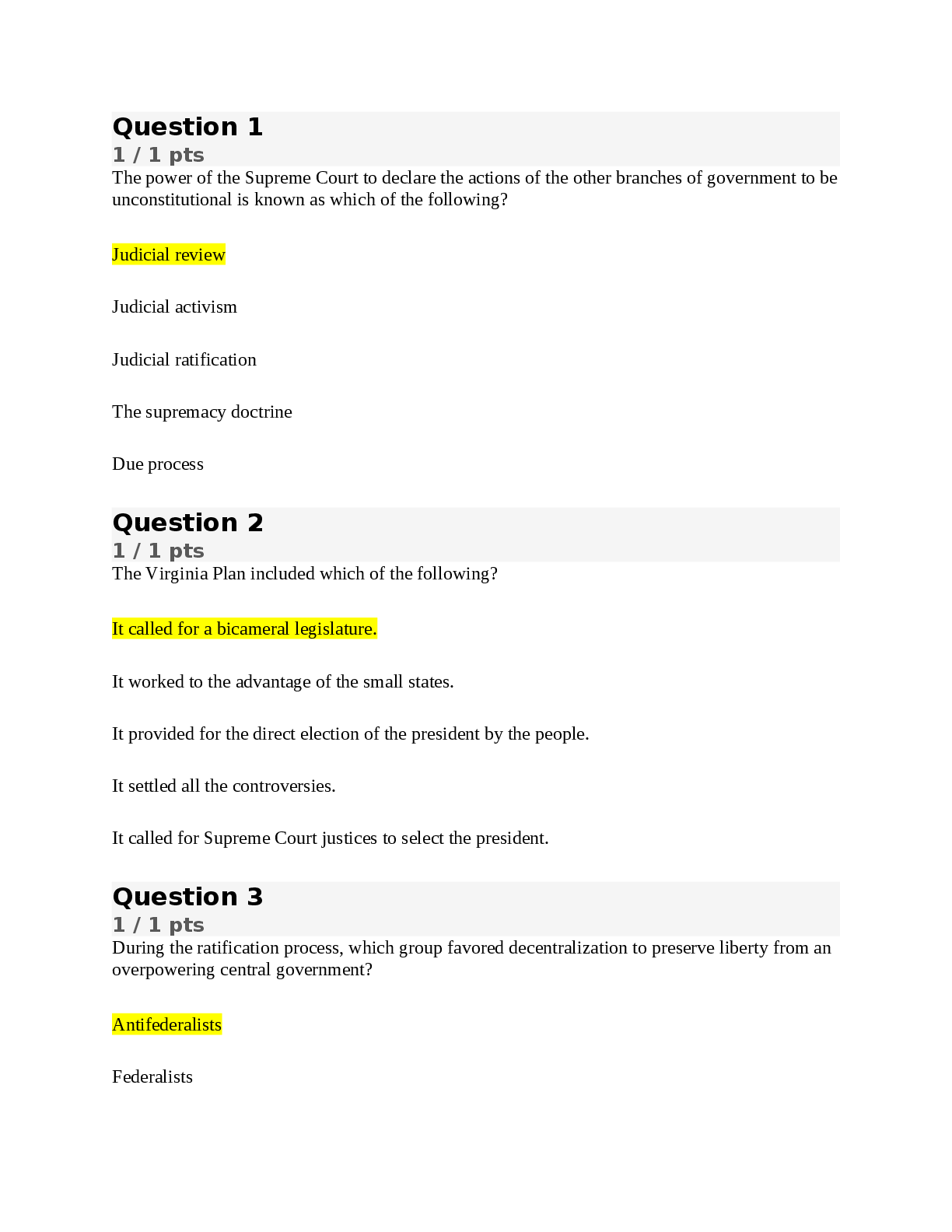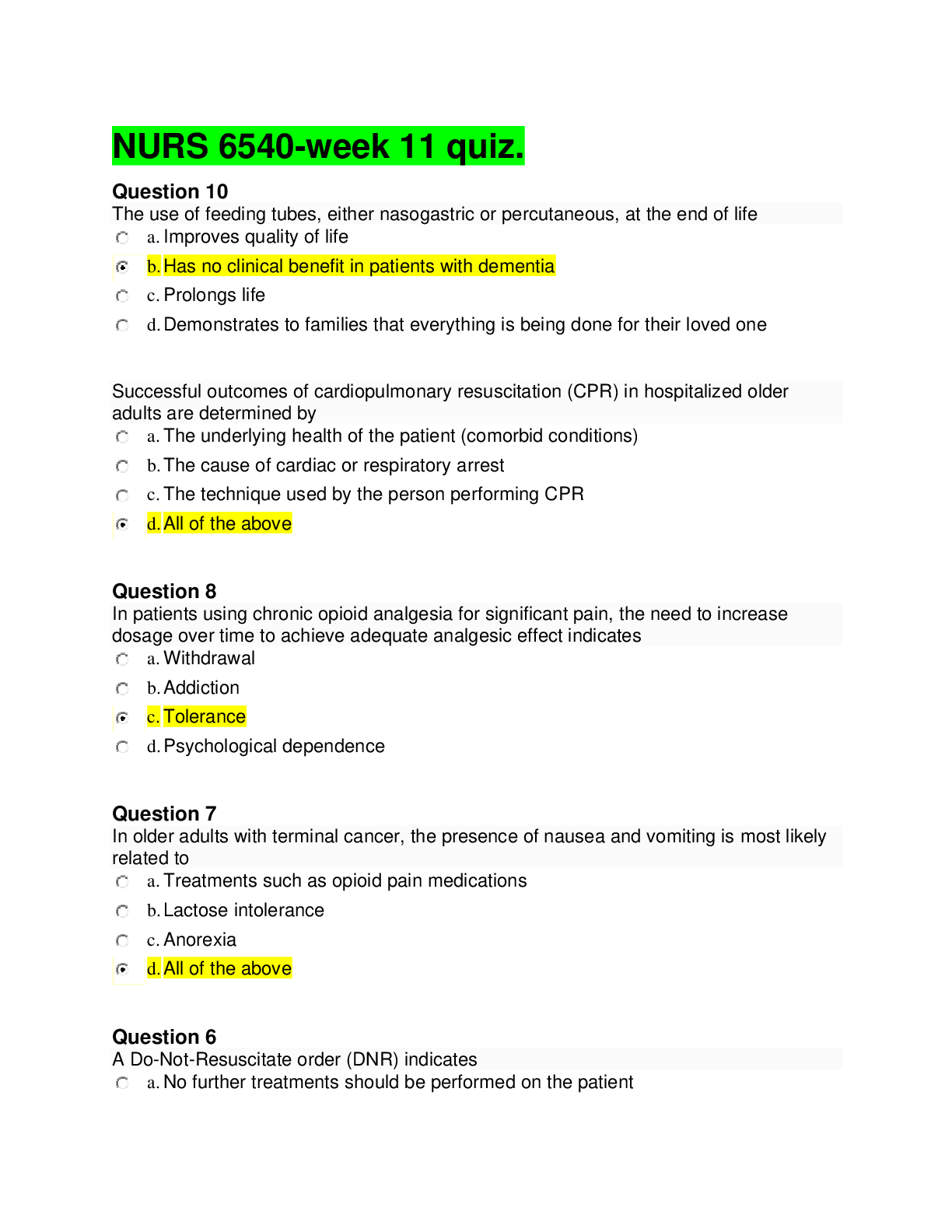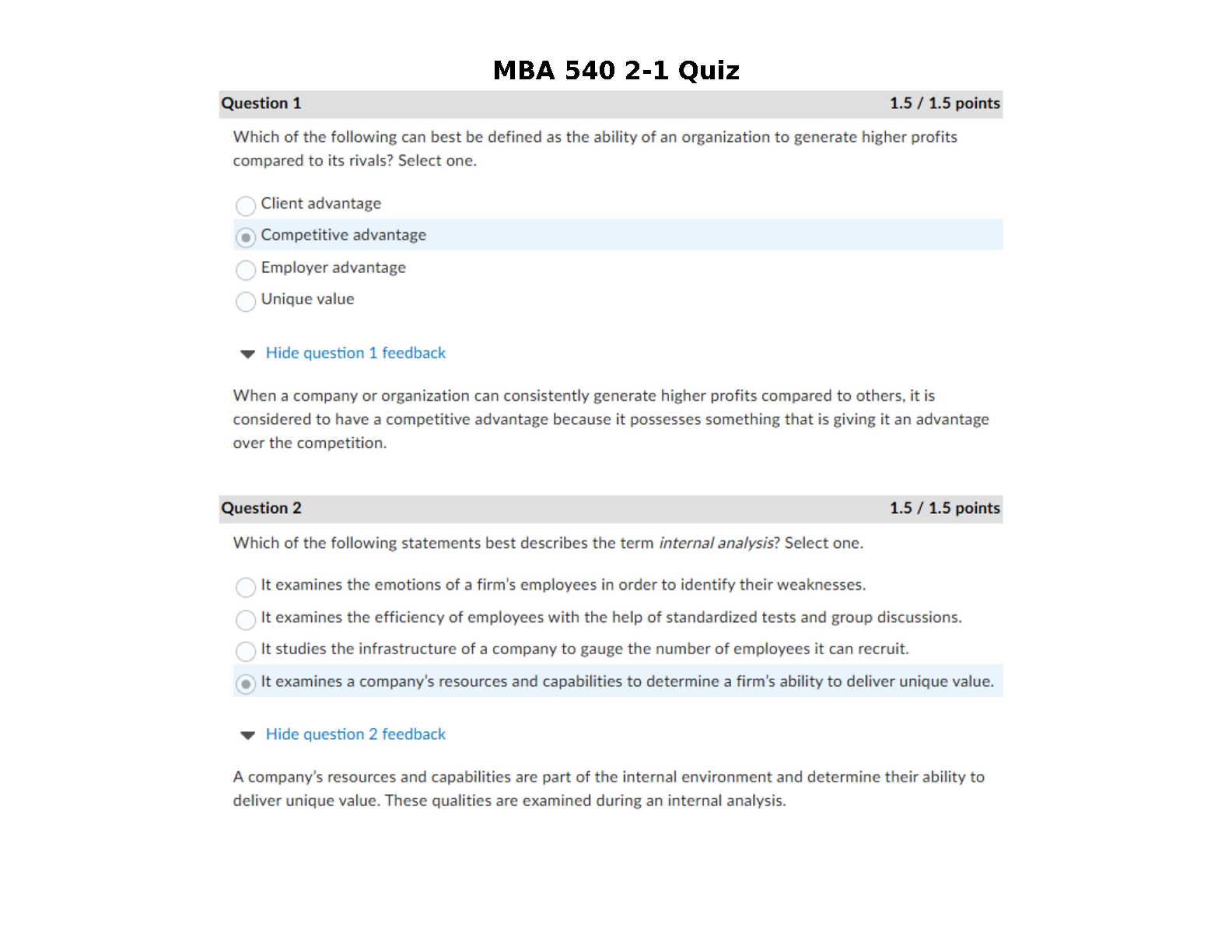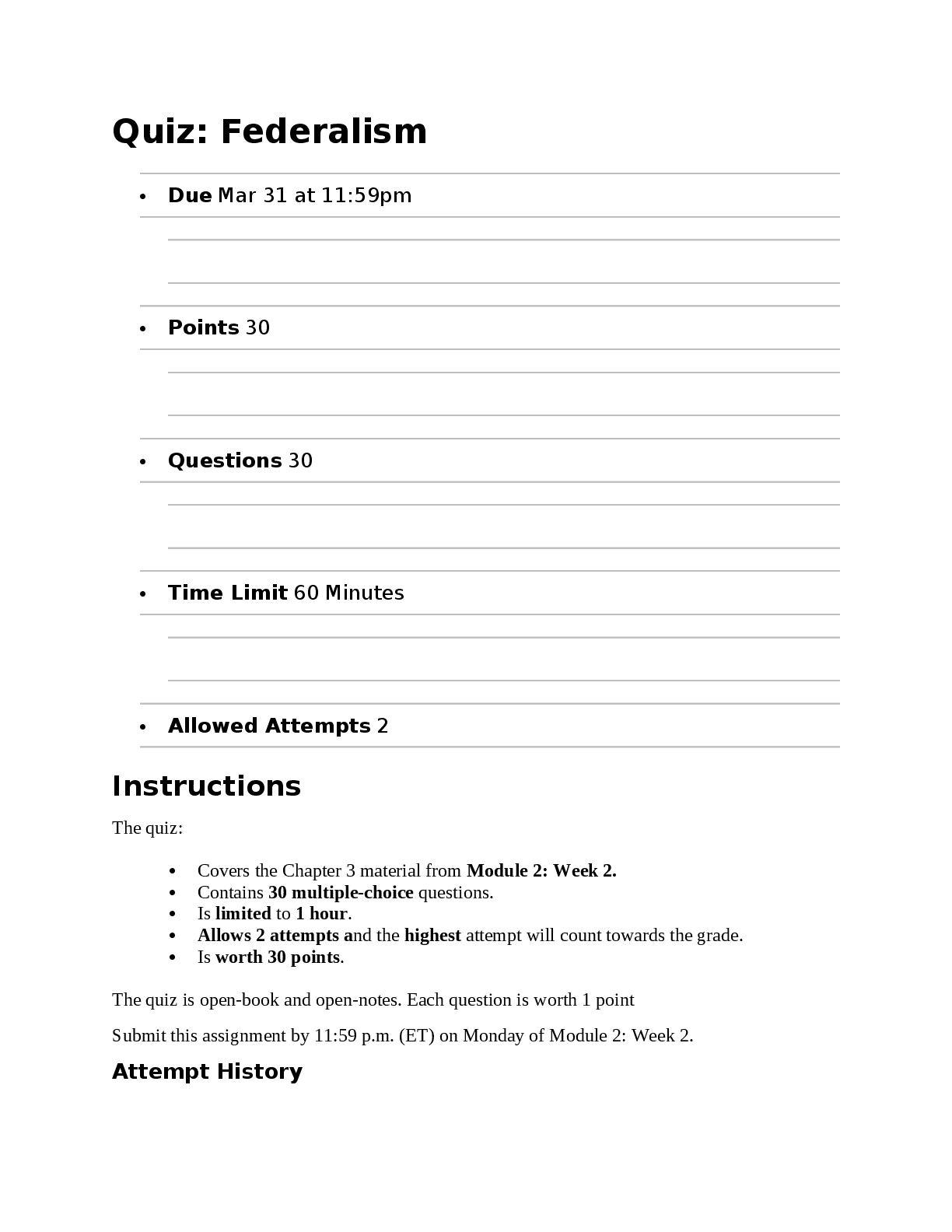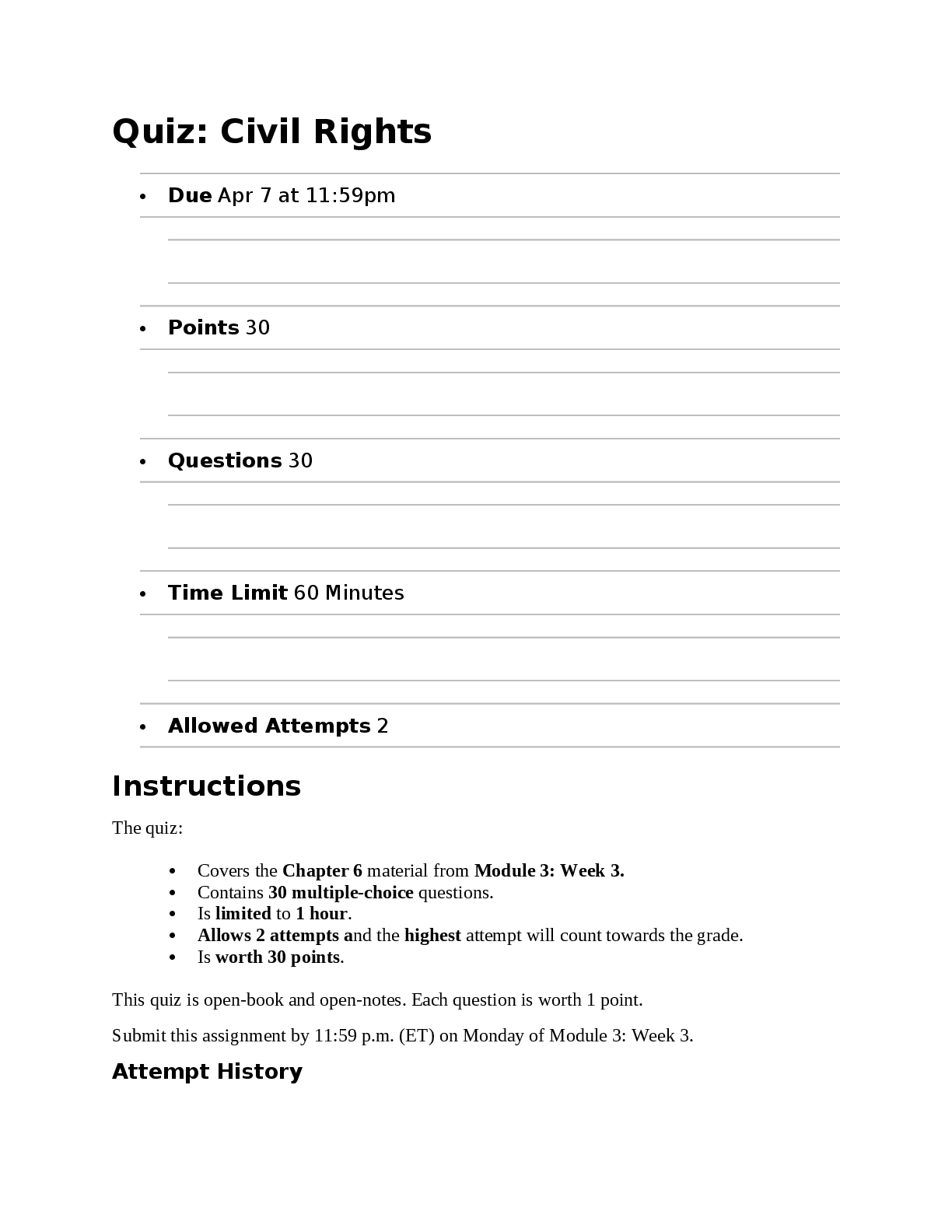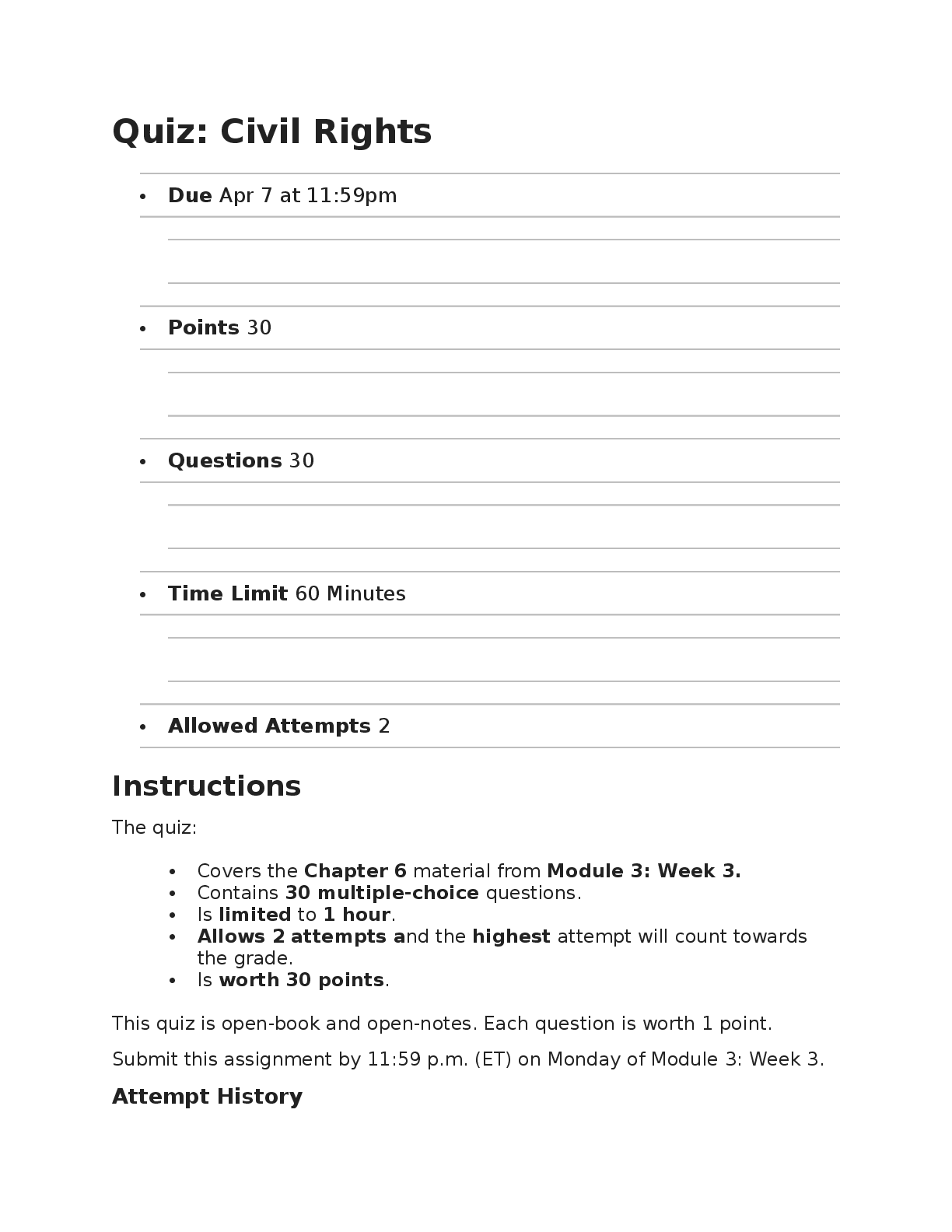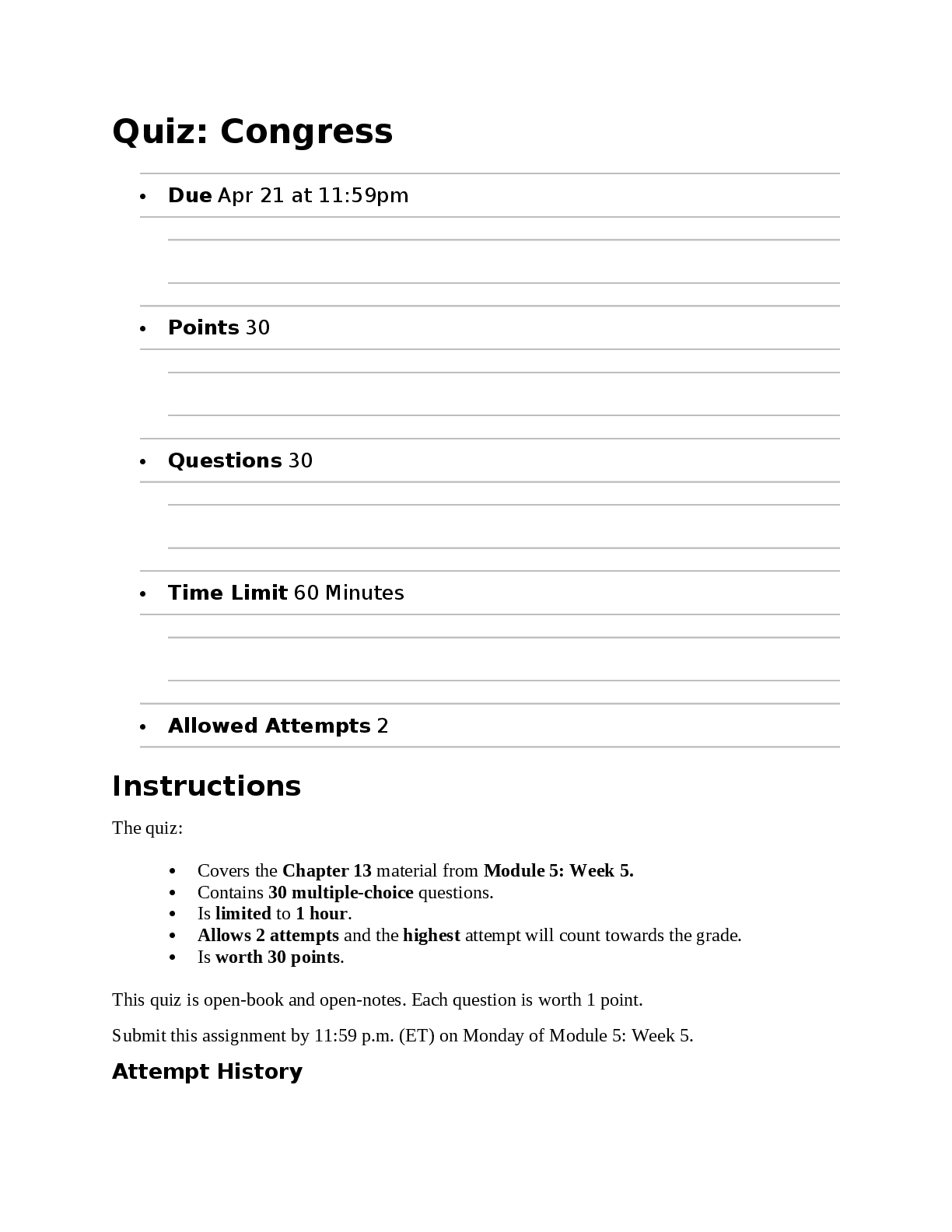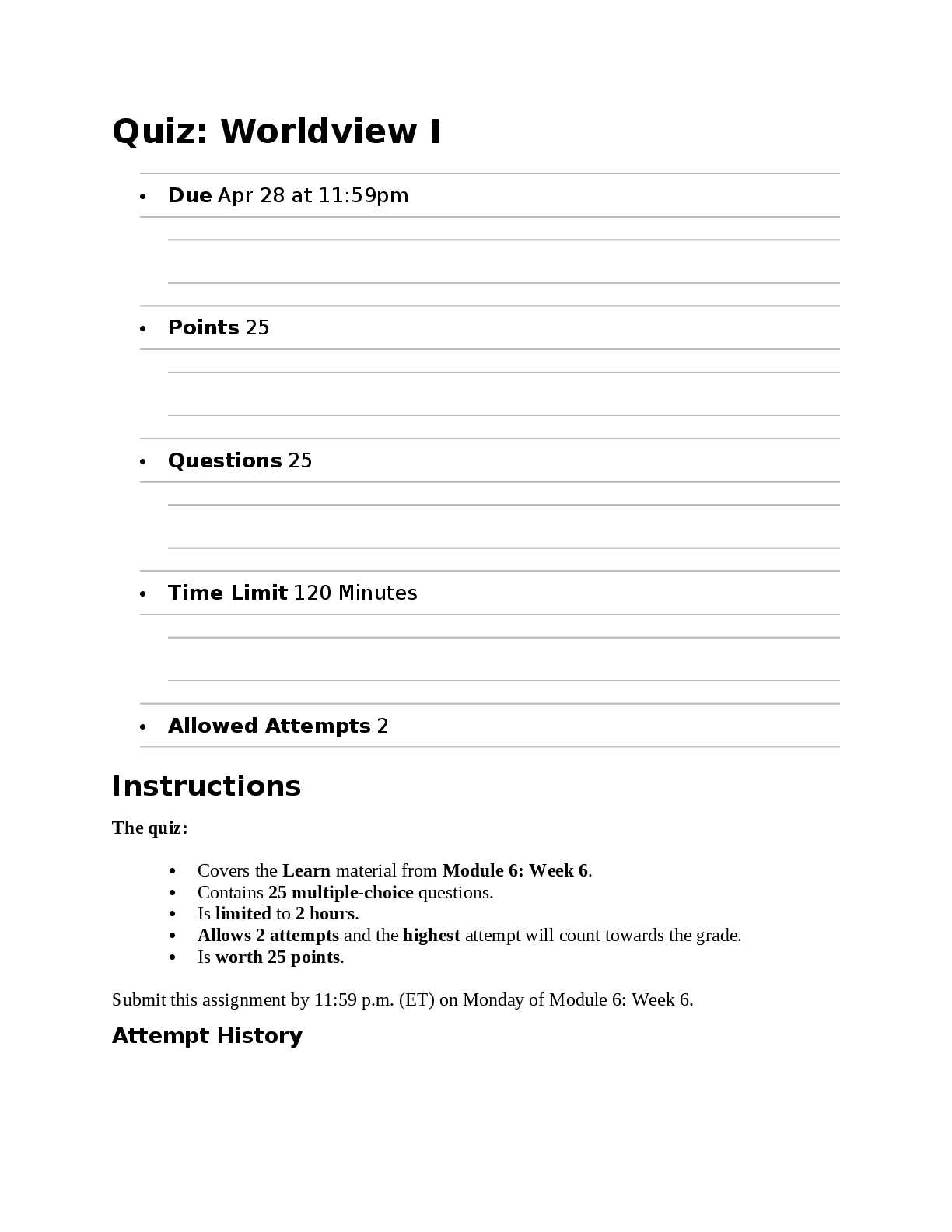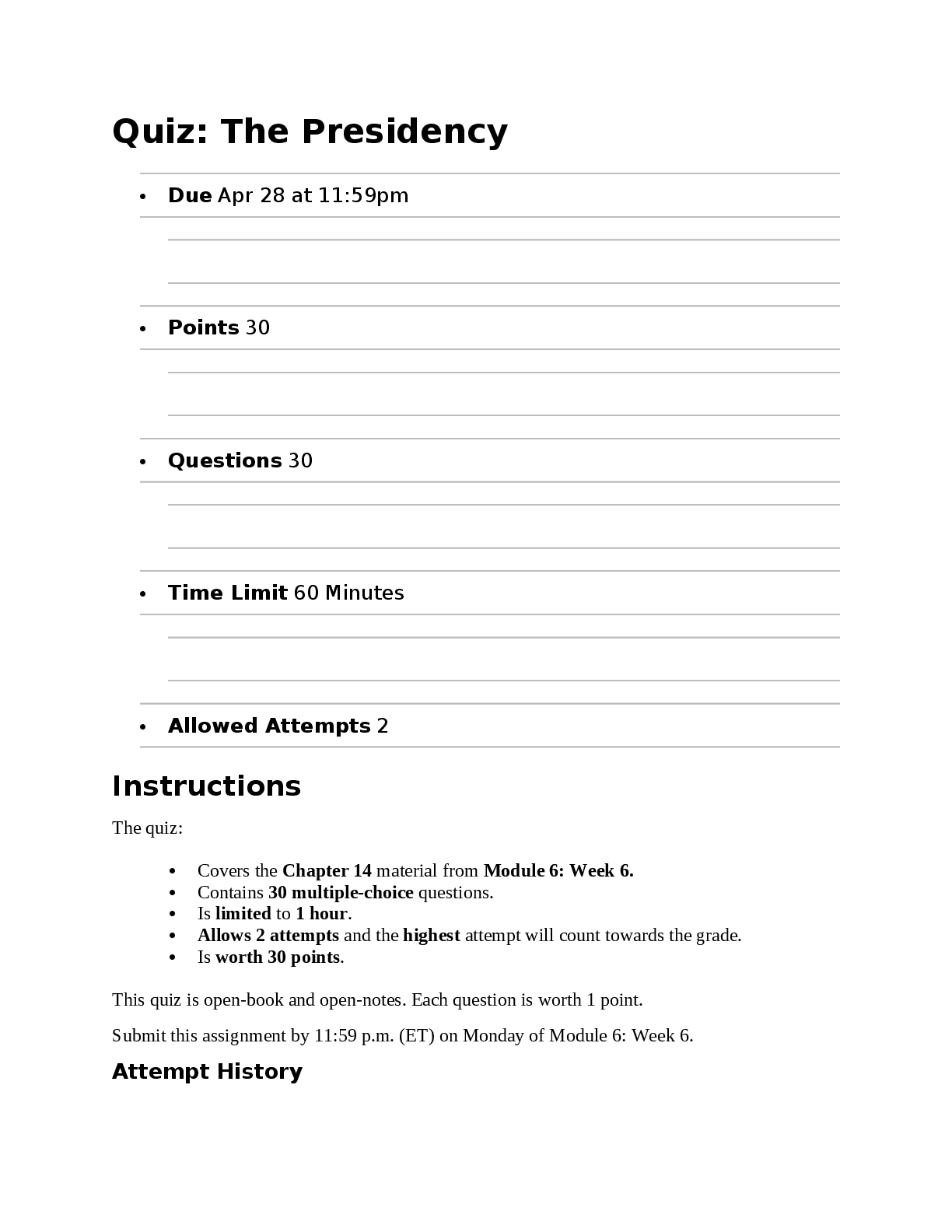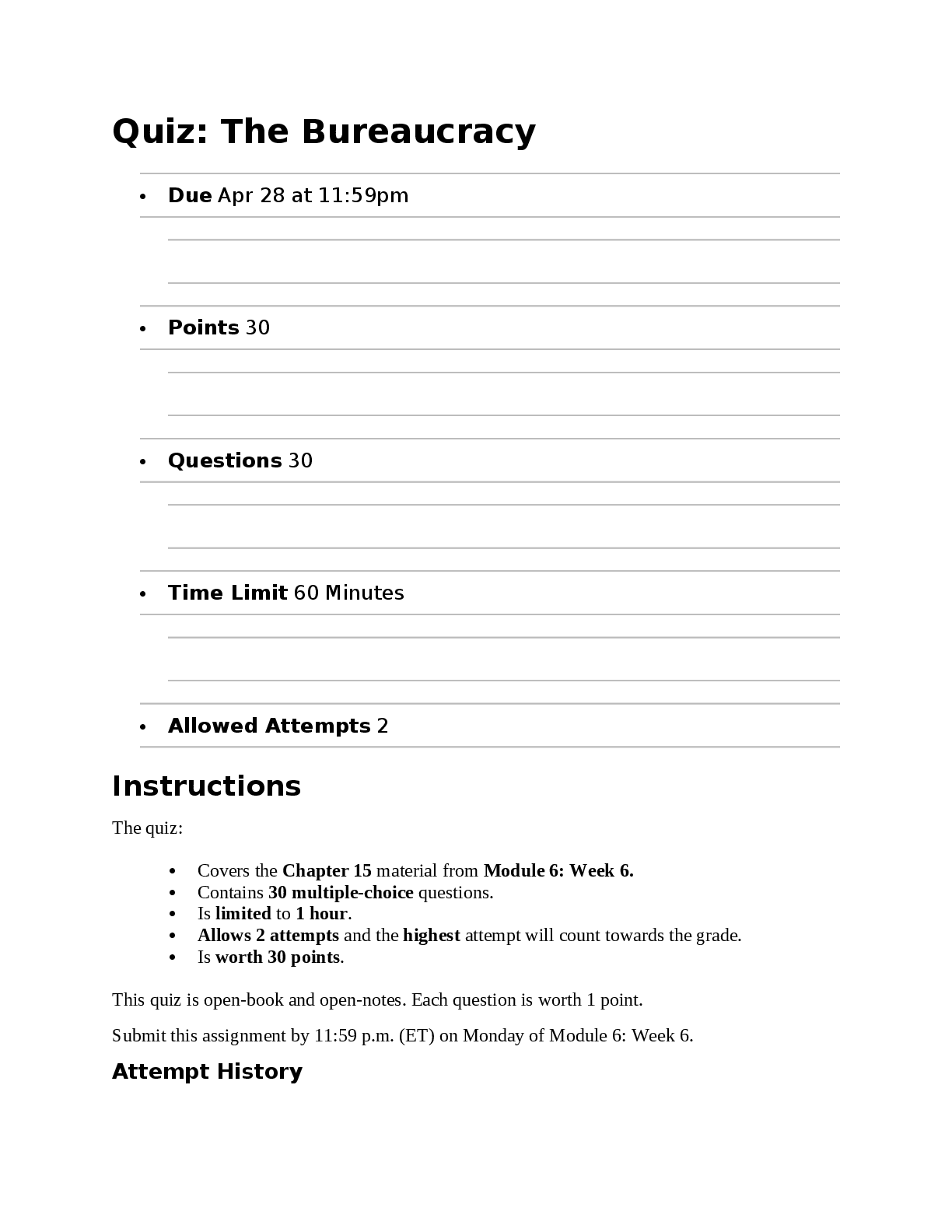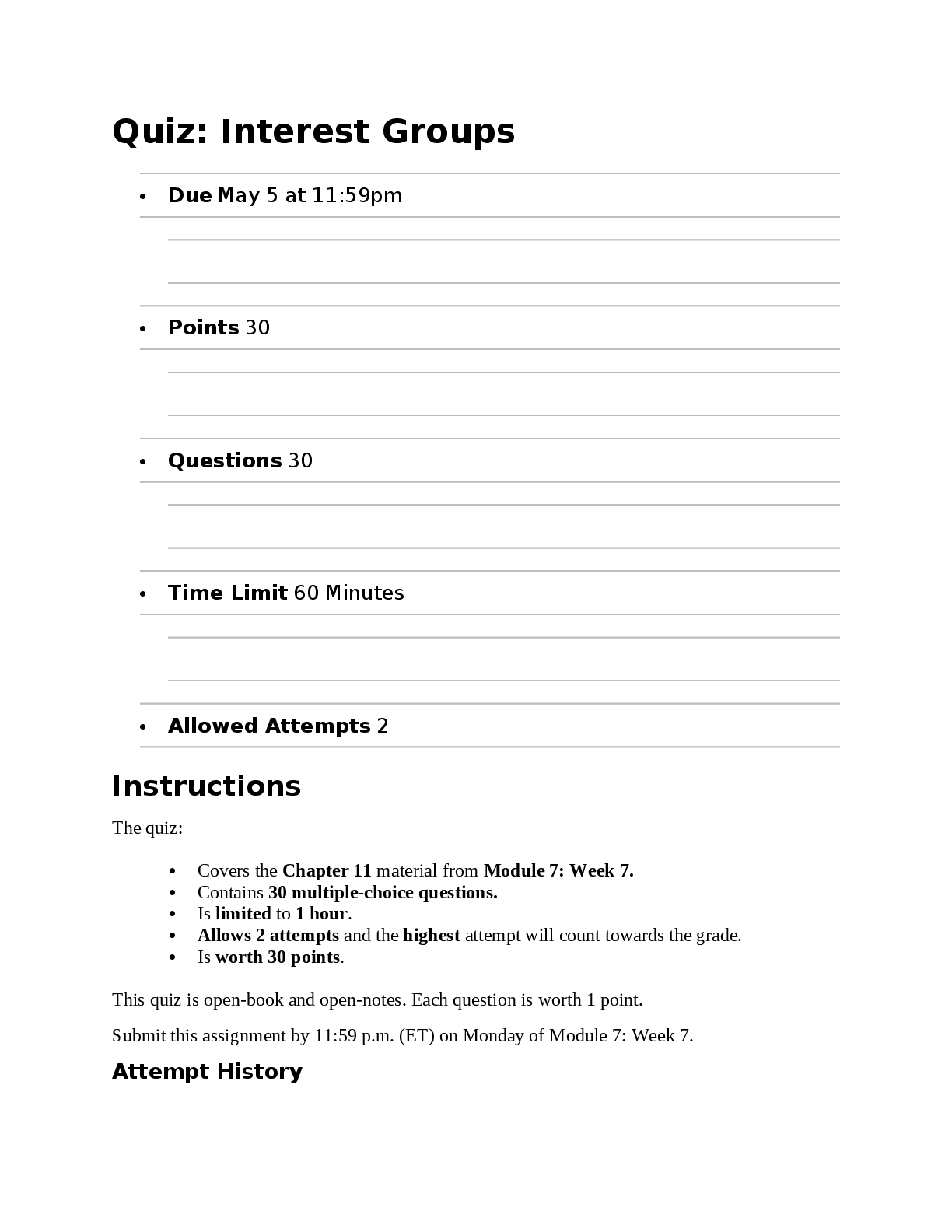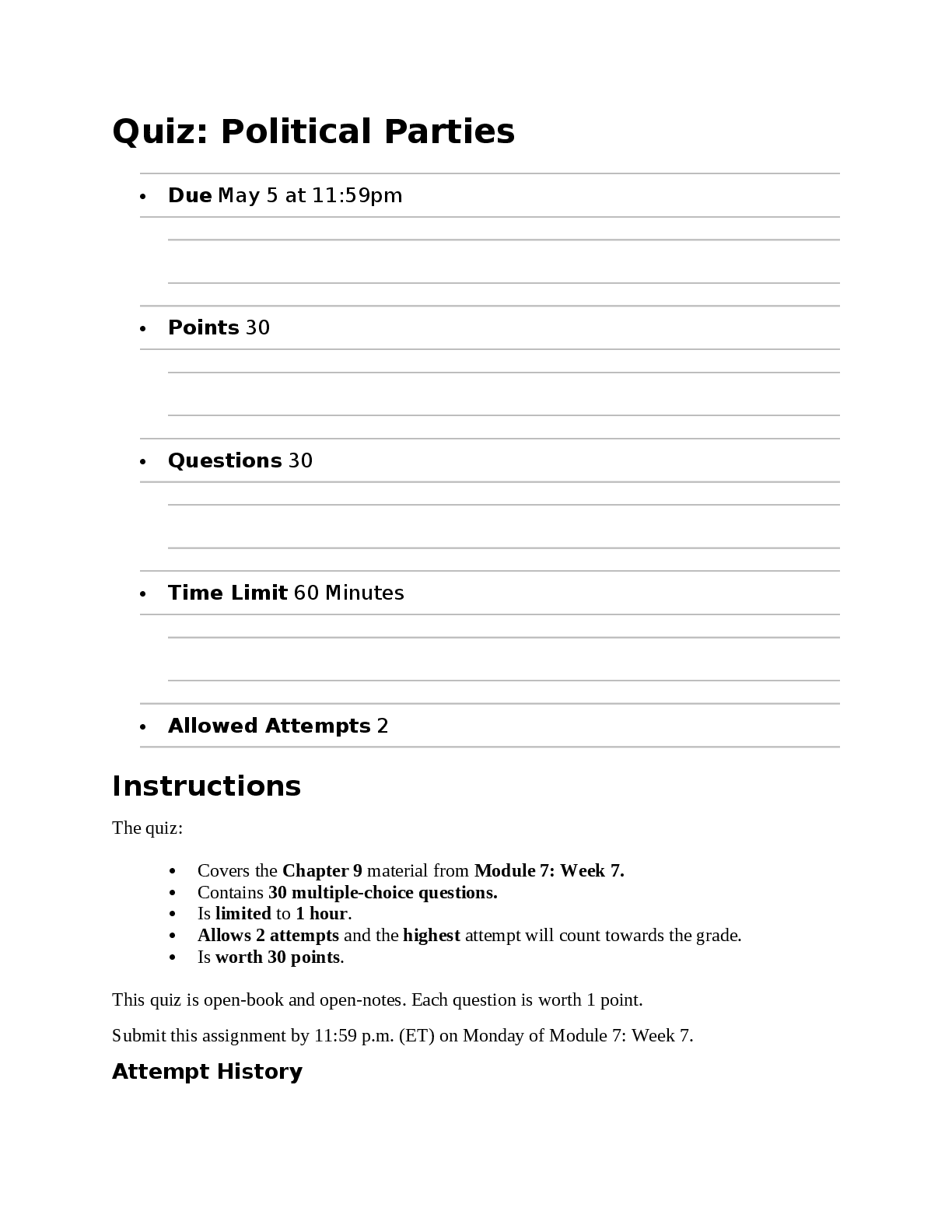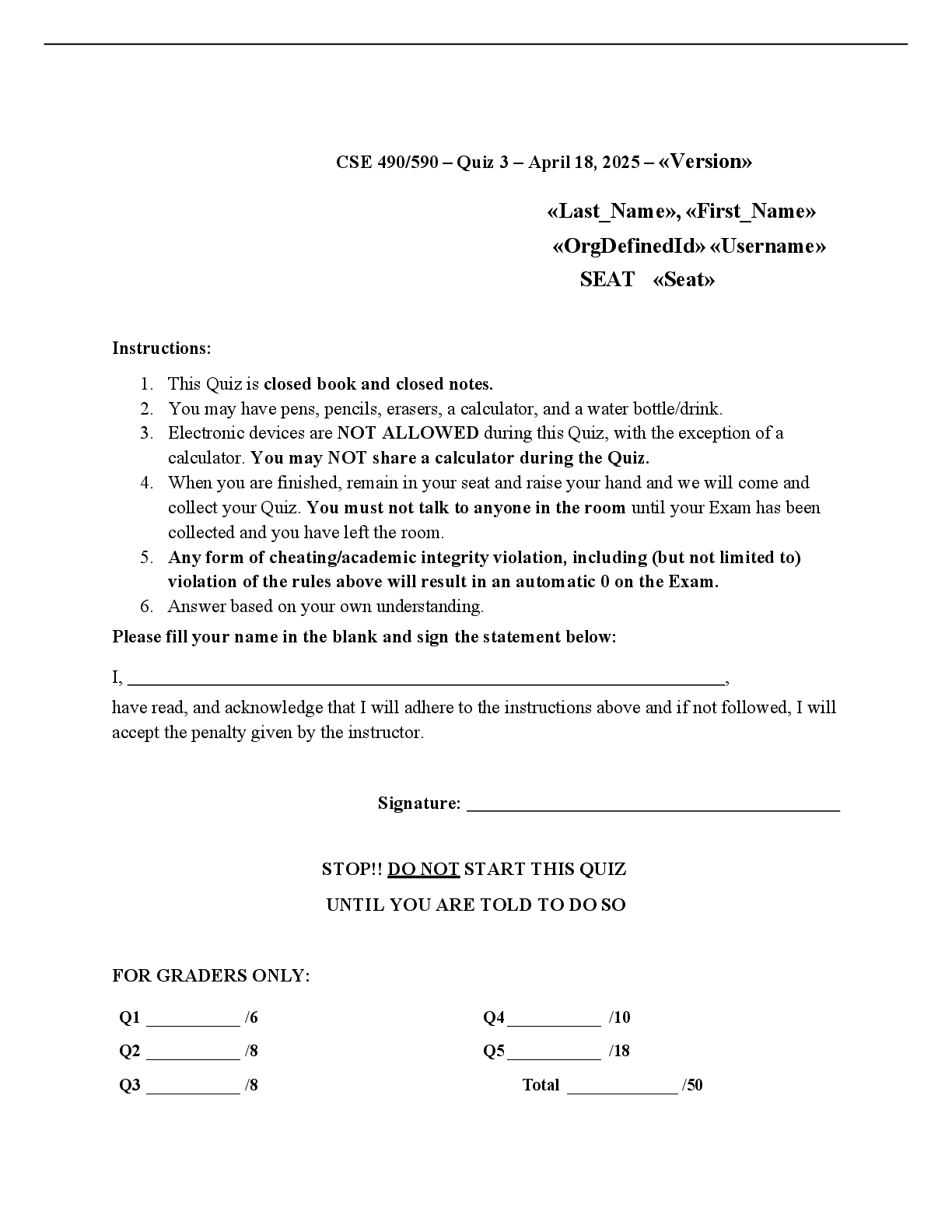Government > Quiz > Liberty University GOVT 220 Quiz 4|100% Complete Questions and Answers updated 2025/2026. (All)
Liberty University GOVT 220 Quiz 4|100% Complete Questions and Answers updated 2025/2026.
Document Content and Description Below
Quiz: Civil Rights Question 1 1 / 1 pts In what case did the Supreme Court declare that states could not prohibit sexual activity between people of the same sex, reversing a 1986 decision that asse... rted same-sex sexual activity was not a fundamental right? Bakke v. California Bowers v. Hardwick Obergefell v. Hodges Lawrence v. Texas Shelley v. Kraemer Question 2 1 / 1 pts The Supreme Court has created three standards of review to determine if a law is discriminatory. What is the toughest of these standards, requiring that a law be narrowly tailored, called? Heightened scrutiny Strict scrutiny Elevated scrutiny Rational basis Normal basis Question 3 1 / 1 pts In what case did the Supreme Court rule that the section of Defense of Marriage Act that limited spousal recognition under federal law to a man and a woman is unconstitutional? United States v. Windsor United States v. Spyer United States v. Roth United States v. Newby United States v. Nixon Question 4 1 / 1 pts Which amendment to the U.S. Constitution appeared to guarantee equal rights for African American persons but did not? First Fourteenth Twenty-First Twenty-Fifth Twenty-Sixth Question 5 1 / 1 pts Unlike the Civil Rights Act, what does the Americans with Disabilities Act (ADA) consider? The impact on local communities Qualifications and standards Quotas Reverse discrimination Undue hardship Question 6 1 / 1 pts In the 2003 decision of Lawrence v. Texas, the U.S. Supreme Court did which of the following? Upheld an existing Texas law that made homosexual conduct a crime Overturned laws against sexual activity between same-sex consenting adults in private Invalidated antidiscrimination laws that protect the LGBTQ community Upheld the Court's previous decision regarding sexual activity between same-sex consenting adults Indicated that states could declare sexual activity between same-sex consensual adults a crime Question 7 1 / 1 pts What was the goal or purpose of the 1848 Seneca Falls Convention? Promote issues based on the notion that men and women are created equal Debate the possibility of seceding from the United States due to restrictions on the slave trade Create a women's manifesto discussing temperance, abolition, and suffrage Discuss strategies for the abolition of slavery Plan strategies that would advance rights for LGBTQ individuals and samesex couples Question 8 1 / 1 pts What did the U.S. Supreme Court rule in Plessy v. Ferguson (1896)? It ruled that African Americans are not persons for the purposes of the Constitution. It tried to stop the development of legal racial segregation known as Jim Crow laws. It stated that schools may not practice any type of racial segregation. It agreed that the separation of races is not a violation of the Constitution. It ruled that the practice of slavery must cease before the end of the century. Question 9 1 / 1 pts What is the term for the expectation that citizens may not be discriminated against on account of race, gender, or national background and should have an equal chance to succeed in life? Equality of opportunity Equality of chance Equality of outcome Equality of circumstance Equality of government Question 10 1 / 1 pts In the Slaughter-House Cases (1873), what did the Supreme Court rule? The “privileges and immunities” clause of the Fourteenth Amendment did not protect citizens from discriminatory actions by state governments. Separate facilities were acceptable as long as they were equal. Segregation was unconstitutional. Literacy tests were acceptable. Juries could be all of one race. Question 11 1 / 1 pts The separate-but-equal doctrine contends that separate-but-equal facilities do not violate which of the following? The equal protection clause The principle of reverse discrimination The strict scrutiny standard The idea of affirmative action The due process of law restriction Question 12 1 / 1 pts Which of the following did the Fifteenth Amendment do? Abolished slavery Provide equal protection under the law Abolished private discrimination State that the right to vote shall not be abridged on account of race Established due process under the law Question 13 1 / 1 pts What did the Nineteenth Amendment do? End racial segregation in the United States Abolish slavery Eliminate racial restrictions on voting Expand the right to vote to women Lower the minimum voting age to 18 Question 14 1 / 1 pts Which of the following best describes the concept of civil rights? Rights generally accorded to all citizens Political rights of speech and assembly Rights extended to citizens from legislative action Guarantees of life, liberty, and property granted to all citizens Powers and privileges guaranteed to individuals and protected by the government to ensure equal protection and freedom from discrimination Question 15 1 / 1 pts What does the concept of strict liability imply? An employer who was aware of a subordinate’s wrongdoing cannot be found at fault. An employer who was aware of a subordinate’s wrongdoing must be found at fault unless the wrongdoing was minor. An employer who was aware of a subordinate’s wrongdoing may still be found blameless. An employer who was unaware of a subordinate’s wrongdoing cannot be found at fault. An employer who was unaware of a subordinate’s wrongdoing can still be found at fault. Question 16 1 / 1 pts Which amendment forbade the states from denying any person "equal protection under the law"? Tenth Twelfth Thirteenth Fourteenth Fifteenth Question 17 1 / 1 pts The origin of the movement to give more rights to women was? The Rights Manifesto The Seneca Falls Convention The Nineteenth Amendment The “Rosie the Riveter” worker The Equal Rights Amendment Question 18 1 / 1 pts The verdict of Plessy v. Ferguson directly resulted in which of the following? The integration of public schools in the South The development of a system of legalized racial segregation The end of racial segregation A constitutional amendment granting Congress more power to deal authoritatively with racial problems A complex system of busing to alleviate the effects of past racism Question 19 1 / 1 pts What is the difference between de facto and de jure segregation? The former results from private choices and the latter from public law. The former results from public law and the latter from private choices. The former existed in the past and the latter continues in the present. The former continues in the present and the latter existed in the past. The former deals with perceptions and the latter deals with verified facts. Question 20 1 / 1 pts If legislators want to create a law that will pass strict scrutiny, they must be certain that the law does which of the following? Be justified by a compelling government interest Be broadly tailored to meet multiple government interests Be rationally related to a government interest Be the most restrictive means to accomplish the goal Be supported by a large majority of citizens Question 21 1 / 1 pts What did the Supreme Court rule in Masterpiece Cakeshop v. Colorado Civil Rights Commission? The Court failed to reach an opinion about whether a baker must make a cake for a same-sex couple. There is no religious exception, and the baker must make a same-sex couple a cake. A baker with a religious objection does not have to make a wedding cake for a same-sex couple. The Court did not believe the state had a compelling interest to rule. The Court ruled that the baker could refuse service regardless of the reason. Question 22 1 / 1 pts The Supreme Court’s ruling in Bowers v. Hardwick suggested that the right to privacy does not protect what? Issues related to the family Marriage Procreation Consensual same-sex sexual activity Abortion Question 23 1 / 1 pts Which of the following statements concerning the right to privacy is correct? It is said to emanate from provisions in the Fourteenth Amendment. It is not mentioned in the Constitution. It is explicitly mentioned in the First and Fifth Amendments. It is explicitly mentioned in the First, Second, and Fifth Amendments. It is explicitly mentioned in the Preamble of the Constitution. Question 24 1 / 1 pts Which of the following terms refers specifically to the rights of all Americans to equal treatment under the law? Civil liberties Civil rights Common law rights Inalienable rights Natural rights Question 25 1 / 1 pts In which seminal Supreme Court decision did the Court overturn its decision in Bowers by ruling that state laws may not ban sexual relations between same-sex partners? Lawrence v. Texas Loving v. Virginia Bakke v. California Johnson v. Texas Boy Scouts of America v. Dale Question 26 1 / 1 pts What did the Supreme Court rule in Fisher v. University of Texas at Austin? A university may consider race as one of many factors in admissions decisions to create a diverse group of students. A university may not consider race as a factor in admissions. A university can only consider race if its student body is more than 80% white. A university must implement strict "color-blind" admissions policies and may not ask applicants about their race or ethnicity. A university is required to implement racial quotas that reflect demographic patterns in the community. Question 27 1 / 1 pts What did Dr. Martin Luther King, Jr. advocate to achieve racial justice? Violence Nonviolent civil disobedience Race riots Enforcing segregation and creating superior public services for Black persons Black militancy Question 28 1 / 1 pts Though the civil rights movement focused primarily on the rights of this group, it had what additional effect? African Americans; benefiting nearly all minority groups Women; benefiting LGBTQ Americans as well Latinos; benefiting African Americans African Americans; strengthening the disenfranchisement of other racial minorities Women; strengthening the disenfranchisement of LGBTQ Americans Question 29 1 / 1 pts What is compensatory action? Compensatory action is helping disadvantaged people catch up. Compensatory action is giving money to disadvantaged people. Compensatory action is reverse discrimination. Compensatory action is giving preference to minorities. Compensatory action is giving extra education, training, or services to advantaged people. Question 30 1 / 1 pts While the Brown ruling was historic, the ruling itself did little to desegregate schools due to its ambiguous command that schools should desegregate in what way? With all deliberate speed With all due process With extreme prejudice With all practical manner With all good intent Quiz Score: 30 out of 30 Last Attempt Details: Time: 37 minutes Current Score: 30 out of 30 Kept Score: 30 out of 30 2 Attempts so far View Previous Attempts No More Attempts available [Show More]
Last updated: 3 weeks ago
Preview 4 out of 14 pages

Loading document previews ...
Buy this document to get the full access instantly
Instant Download Access after purchase
Buy NowInstant download
We Accept:

Reviews( 0 )
$12.50
Can't find what you want? Try our AI powered Search
Document information
Connected school, study & course
About the document
Uploaded On
Jul 07, 2025
Number of pages
14
Written in
Additional information
This document has been written for:
Uploaded
Jul 07, 2025
Downloads
0
Views
12
